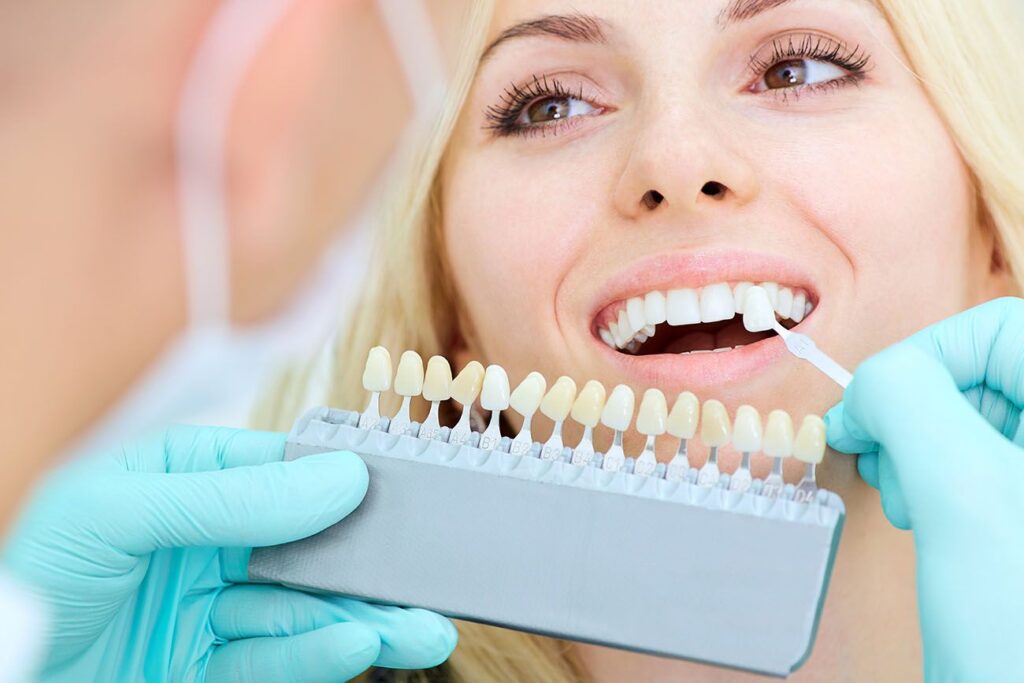Achieving a bright, white smile is a common desire for many people. Fortunately, modern dentistry offers effective solutions for whitening teeth and improving the look of your smile. Teeth whitening is a quick and effective way to improve your smile drastically.

What Causes Tooth Stains?
Teeth can become stained or discolored due to various factors, including:
- Consumption of pigmented foods and drinks such as coffee, tea, red wine, and berries.
- Tobacco use can lead to stubborn surface stains and yellowing of the teeth.
- In the natural aging process, the enamel layer gradually wears down over time. As a result, it reveals the yellowish dentin layer underneath.
- Certain medications, illnesses, or dental treatments can cause changes in tooth color.
The Science Behind Teeth Whitening
Teeth whitening is a cosmetic dental procedure that lightens the color of the teeth and removes stains or discoloration. The process of teeth whitening works by targeting the molecules responsible for tooth discoloration and breaking down the bonds that hold them together.
Types of Teeth Whitening
There are two primary methods of teeth whitening commonly used by dentists: in-office whitening and at-home whitening.
In-Office Whitening
In-office whitening involves the application of a bleaching gel to the teeth. They will activate the gel with a special light or laser. The bleaching gel penetrates the enamel and breaks down the stains. This leaves the teeth several shades whiter in just one visit to the dentist.
At-Home Whitening
At-home whitening kits typically consist of custom-fitted trays and a lower-concentration bleaching gel. Patients are instructed to wear the trays filled with the bleaching gel for a specified amount of time each day, usually for a few weeks, to achieve gradual whitening results.
How Teeth Whitening Works
Regardless of the method used, the active ingredient in most whitening products is either hydrogen peroxide or carbamide peroxide. These bleaching agents penetrate the enamel and oxidize the pigmented molecules that cause tooth discoloration. The bleaching agent breaks down into oxygen molecules, which enter the enamel and dentin layers of the teeth.
These oxygen molecules react with the discolored molecules, causing them to break apart and become colorless. As a result, the overall appearance of the teeth is lightened. Then, stains or discoloration are reduced. This leaves behind a brighter, whiter smile.
Factors Affecting Whitening Results
Several factors can influence the effectiveness of teeth whitening treatment, including:
Severity and type of stains: Teeth whitening is most effective for surface stains caused by external factors such as food and drink consumption. Deeper, intrinsic stains may require additional or alternative treatments.
Concentration of bleaching agent: Higher concentrations of bleaching gel used in in-office whitening treatments typically yield faster and more dramatic results compared to at-home whitening kits.
Compliance with instructions: Following the dentist’s instructions for wearing at-home whitening trays or attending follow-up appointments for in-office treatments is essential for achieving optimal whitening results.
Overall oral health: Teeth whitening may not be suitable for those with certain dental conditions such as cavities, gum disease, or enamel erosion. Addressing these underlying oral health issues may be necessary before undergoing whitening treatment.
